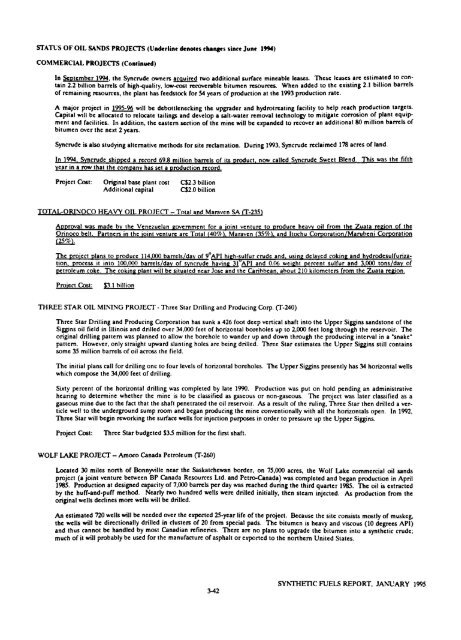Ikelic - Alliance Digital Repository
Ikelic - Alliance Digital Repository
Ikelic - Alliance Digital Repository
You also want an ePaper? Increase the reach of your titles
YUMPU automatically turns print PDFs into web optimized ePapers that Google loves.
STATUS OF OIL SANDS PROJECTS (Underline denotes changes since June 1994)<br />
COMMERCIAL PROJECTS (Continued)<br />
In September 1994. the Syncrude owners acquired two additional surface mineable leases. These leases are estimated to con<br />
tain 2.2 billion barrels of high-quality, low-cost recoverable bitumen resources. When added to the existing 2.1 billion barrels<br />
of remaining resources, the plant has feedstock for 54 years of production at the 1993 production rate.<br />
A major project in 1995-96 will be debottlenecking the upgrader and hydrotreating facility to reach production targets.<br />
help<br />
Capital will be allocated to relocate tailings and develop a salt-water removal technology to mitigate corrosion of plant equip<br />
ment and facilities. In addition, the eastern section of the mine will be expanded to recover an additional 80 million barrels of<br />
bitumen over the next 2 years.<br />
Syncrude is also studying alternative methods for site reclamation. During 1993, Syncrude reclaimed 178 acres of land.<br />
In 1994. Syncrude shipped a record 69.8 million barrels of its product, now called Syncrude Sweet Blend. This was the fifth<br />
year in a row that the company has set a production record.<br />
Project Cost: Original base plant cost C$2.3 billion<br />
Additional capital C$2.0 billion<br />
- TOTAL-ORINOCO HEAVY OIL PROJECT Total<br />
and Maraven SA (T-235)<br />
Approval was made bv the Venezuelan government for a joint venture to produce heavy oil from the Zuata region of the<br />
Orinoco belt. Partners in the joint venture are Total (407r). Maraven (35%). and Itochu Corporation /Marubeni Corporation<br />
(25%).<br />
The project plans to produce 114.000 barrels/day of 9API high-sulfur crude and, using delayed coking and hvdrodesulfuriza-<br />
tion. process it into 100.000 barrels/day of syncrude having 31 API and 0.06 weight percent sulfur and 3.000 tons/day of<br />
petroleum coke. The coking plant will be situated near Jose and the Caribbean, about 210 kilometers from the Zuata region.<br />
Project Cost: $3.1 billion<br />
- THREE STAR OIL MINING PROJECT Three Star Drilling and Producing Corp. (T-240)<br />
Three Star Drilling and Producing Corporation has sunk a 426 foot deep vertical shaft into the Upper Siggins sandstone of the<br />
Siggins oil field in Illinois and drilled over 34,000 feet of horizontal boreholes up to 2,000 feet long through the reservoir. The<br />
original drilling pattern was planned to allow the borehole to wander up and down through the producing interval in a "snake"<br />
pattern. However, only straight upward slanting holes are being drilled. Three Star estimates the Upper Siggins still contains<br />
some 35 million barrels of oil across the field.<br />
The initial plans call for drilling one to four levels of horizontal boreholes. The Upper Siggins presently has 34 horizontal wells<br />
which compose the 34,000 feet of drilling.<br />
Sixty percent of the horizontal drilling was completed by late 1990. Production was put on hold pending an administrative<br />
to determine whether the mine is to be classified as gaseous or non-gaseous. The project was later classified as a<br />
hearing<br />
gaseous mine due to the fact that the shaft penetrated the oil reservoir. As a result of the ruling, Three Star then drilled a ver-<br />
ticle well to the underground sump room and began producing the mine conventionally with all the horizontals open. In 1992,<br />
Three Star will begin reworking the surface wells for injection purposes in order to pressure up the Upper Siggins.<br />
Project Cost: Three Star budgeted $3.5 million for the first shaft.<br />
WOLF LAKE PROJECT - Amoco Canada Petroleum (T-260)<br />
Located 30 miles north of Bonnyville near the Saskatchewan border, on 75,000 acres, the Wolf Lake commercial oil sands<br />
project (a joint venture between BP Canada Resources Ltd. and Petro-Canada) was completed and began production in April<br />
1985. Production at designed capacity of 7,000 barrels per day was reached during the third quarter 1985. The oil is extracted<br />
by the huff-and-puff method. Nearly two hundred wells were drilled initially, then steam injected. As production from the<br />
original wells declines more wells will be drilled.<br />
An estimated 720 wells will be needed over the expected 25-year life of the project. Because the site consists mostly of muskeg,<br />
the wells will be directionally drilled in clusters of 20 from special pads. The bitumen is heavy and viscous (10 degrees API)<br />
and thus cannot be handled by most Canadian refineries. There are no plans to upgrade the bitumen into a synthetic crude;<br />
much of it will probably be used for the manufacture of asphalt or exported to the northern United States.<br />
3-42<br />
SYNTHETIC FUELS REPORT, JANUARY 1995















![pace SrntfletIc fne]its report - Alliance Digital Repository](https://img.yumpu.com/10493335/1/190x245/pace-srntfletic-fneits-report-alliance-digital-repository.jpg?quality=85)
